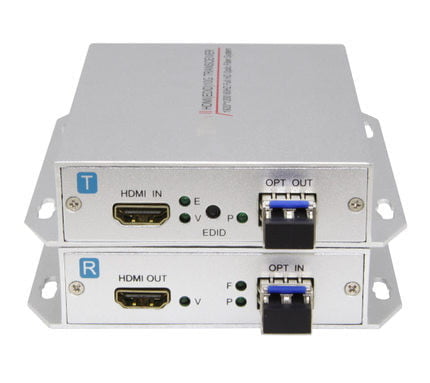HDMI over fiber optic video converter transmitter and receiver set is a device that enables the transmission of high-definition (HD) video and audio signals over long distances using fiber optic cables. This technology is commonly used in situations where traditional copper-based HDMI cables are not practical or suitable, such as in large-scale installations, broadcasting, and live events.
The transmitter unit takes an HDMI signal, converts it into an optical signal, and transmits it over a fiber optic cable to the receiver unit. The receiver unit then converts the optical signal back to an HDMI signal and sends it to the display device. This process ensures that the signal is transmitted with minimal loss of quality over long distances.
The use of fiber optic cables provides several advantages over traditional copper-based cables, including increased bandwidth, longer transmission distances, and improved resistance to electromagnetic interference. Additionally, fiber optic cables are thinner and more flexible than copper cables, making them easier to install in tight spaces.
HDMI over fiber optic video converter transmitter and receiver sets are available in a wide range of configurations, with varying transmission distances, resolutions, and audio capabilities. They are commonly used in professional AV installations, as well as in home theater and gaming applications where long cable runs are required.
HDMI over fiber optic video converter transmitter and receiver sets have a wide range of applications in both professional and consumer settings. Some common applications include:
Live events: HDMI over fiber optic converters are commonly used in live event production, such as concerts, trade shows, and conferences. They allow for the transmission of high-quality video and audio over long distances without degradation, ensuring that the audience receives a clear and consistent signal.
Broadcast: In broadcast applications, HDMI over fiber optic converters are used to transmit video and audio signals from cameras and other equipment to control rooms and production facilities. This allows for remote monitoring and control of the equipment, as well as the ability to switch between different video sources.
Digital signage: HDMI over fiber optic converters are often used in digital signage installations, where displays are located in multiple locations throughout a building or campus. The converters enable the transmission of high-quality video and audio signals over long distances, ensuring that the displays are synchronized and consistent.
Home theater: In home theater applications, HDMI over fiber optic converters are used to transmit high-definition video and audio signals from source devices, such as Blu-ray players and game consoles, to displays and audio systems located in other parts of the home. This allows for a more flexible and customizable home theater setup.
Medical imaging: HDMI over fiber optic converters are also used in medical imaging applications, such as in operating rooms and radiology departments. They enable the transmission of high-quality video signals from medical imaging equipment to displays and recording devices, ensuring that medical professionals have access to clear and accurate images.
When choosing an HDMI over fiber optic converter, there are several factors to consider, including:
Transmission distance: One of the most important factors to consider when selecting an HDMI over fiber optic converter is the transmission distance. Different converters have varying transmission distances, so it’s important to choose one that can transmit the signal over the required distance without signal loss or degradation.
Video resolution: Another important factor to consider is the video resolution supported by the converter. Some converters only support lower resolutions, such as 1080p, while others support higher resolutions, such as 4K or even 8K. It’s important to choose a converter that is compatible with the video resolution of the source device and display.
Audio support: Some HDMI over fiber optic converters also support audio transmission, while others only support video. If audio transmission is required, it’s important to choose a converter that supports the required audio format, such as Dolby Digital or DTS.
Compatibility: It’s essential to ensure that the HDMI over fiber optic converter is compatible with the source device, display, and other equipment in the system. This includes checking for compatibility with HDMI versions, HDCP compliance, and other technical specifications.
Ease of installation: The ease of installation is another important factor to consider, especially for non-professional users. Some HDMI over fiber optic converters require specialized knowledge and equipment to install, while others are designed for easy plug-and-play installation.
Price: Finally, the price of the HDMI over fiber optic converter should also be considered. Different converters have varying price points, so it’s important to choose one that fits within the budget while also meeting the required specifications.
The price of HDMI over fiber optic converters can vary widely depending on the features and specifications of the device. Generally, basic models with lower transmission distances and resolutions can be found for around $100 to $200, while more advanced models with longer transmission distances and higher resolutions can cost several hundred to several thousand dollars.
Some factors that can impact the price of HDMI over fiber optic converters include the transmission distance, resolution, audio support, compatibility with different equipment, ease of installation, and brand reputation. Additionally, some manufacturers may offer additional features or services, such as technical support or warranty coverage, which can affect the price.
It’s important to carefully consider the required specifications and features before choosing an HDMI over fiber optic converter, as selecting a device that doesn’t meet the requirements may result in poor performance or compatibility issues. It’s also important to compare prices and read reviews from other users to ensure that the chosen device offers good value for the price.

